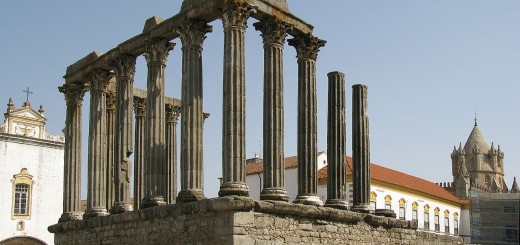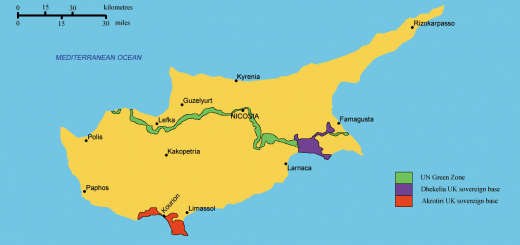Cyprus historical review and geographical details
Cyprus history can be traced back to the Neolithic period in ca 7000 years B.C. The name Kypros or Kuprum came out form the latin word of copper after the vital discovery of significant copper deposits in Cyprus.
It was exactly one of the reasons that Greeks settled and hellenised the island and even though more than twelve different masters have invaded and occupied Cyprus During it’s life, the Greek culture and character always remains.
Historical review
Assyrians, Egyptians and Persians claimed the island repeatedly during the 7th , 6th and 5th centuries. Then Alexander the Great took control of the island in 323 B.C and afterwards Ptolemies created Paphos as their capital on the western part of the island. In the year 58 B.C, Romans came and occupied the country until the division in the year 330 A.D when Cyprus became part of Byzantine empire.
New religion was immediately brought to Cyprus by St Paul and Barnabas in 45 A.D. In spite of continuous Arabs attacks and invasions, Cyprus remained under Byzantium until the year 1191 when Richard the Lionheart has occupied the island and few years later transferred the administration to Lusignians .
The year 1571 is a black date on Cyprus history due to occupation of the island by Turks. This was the first time that Turks and Moslems appear to Cyprus. The occupation took almost four hundred years and during all those years a considerable part of the Greek population, was forced to change the Christian religion, to close down the schools and to learn the Turkish language.
Great Britain took over the administration of the island in 1878 and after the liberation struggle, in 1960 Cyprus got it’s independence. Unfortunately only few years later and due to involvement in the island’s affairs on one hand by Greek military government and on the other hand by Turkish military government, it came to conflict between Greeks and Turks Cypriots and since the Turkish invasion of 1974, appr. 37% of the island’s territory is under occupation and about 200000 Greek Cypriots have become refugees.
Geographical details
Cyprus is the third large island in the Mediterranean with appr distances 240 km from east to west and 95 km from north to south. Very close to Europe, Africa and Asia rightly claims to be the stepping stone to three continents. In the middle of the island Troodos Mountains with Olympus highest point reaches almost 2000 m above sea level. Green valleys full of pine and other fruit trees and vineyards but also rocky highs are offering a panoramic scenery. Traditional villages and isolated monasteries and churches are completing the magnificent landscape. Second high mount the Pentadaktylos partly green with pine trees but a lot with burned areas since the Turkish invasion of 1974.
Mesaoria, the islands largest fields between the two mountains are extended from Morfou bay on the north – west up to Famagusta bay on the east. Citrus plantations and different vegetables are grown everywhere.
Coastal lines around the island with picturesque small and large sandy bays are attracting millions of tourists and locals every year.
Population of Cyprus is appr 700.000 without taking into account the Turkish Cypriots and other immigrants in the Turkish occupied areas where the government has at the moment no control. Although divided since 1974, Nicosia is always the capital of Cyprus with a population of appr 200.000 population , followed by Limassol which is the second town and the biggest port with appr 180.000 inhabitants.
Larnaca and Paphos are smaller towns with appr 100.00 each and of course the two towns in the occupied areas Famagusta and Kyrenia which are for the time being inaccessible.
Cyprus climate is mild although on the mountains there is often snow mainly during the winter months January, February and March. On the coast however temperature is never under 10 C. Due to light winds from the sea , summer is not that hot and maximum temperatures various from 35 to 40 C depending on the area .The 4 years seasons are really different and each one has a charm and beauty of its own.
Today’s political situation and economical development
Although the division of the island continues for more than 27 years, the political situation is stabilized and negotiations are going on between the official government of the Republic of Cyprus and the Turkish Cypriots.
Since the beginning of the conflict, countries like U.K, Greece, European Community, and United Nations are involved in the matter and try to persuade Turkey for a fair solution within the United Nations decisions and resolutions. Such solution has to safeguard the status of one country where the two communities can live in peace, secures human rights and enables all refugees to return to their houses and move and get any job freely within the whole island.
Republic of Cyprus has been recently so much developed and has reached the European standards concerning the cost of living and other factors.Per head income is about 15000 US dollars per annum and it puts Cyprus among the rich countries of the world.
Tourism and services are our main products. Their participation in the gross income of the country is over 50% .The light industry, agriculture and trade have also been developed and efforts and investments are still planned in these sections.
Cyprus has recently applied for joining the European Community and since we comply to almost all requirements, we will soon join the community.
The political situation is certainly a problem, however all EU officials are ensuring that Cyprus will not suffer again because of Turkish occupation and it will join the community with next enlargement .


